Jan Joosten Van Meteren
See my post “Jan Joosten Van Meteren Lineage” to see theories on who his parents were.
Born: Most likely Feb 1630 in Tiel, Tielerwaard, Gelderland, Netherlands.
Baptized: 14 Feb 1630 in Tiel, Tielerwaard, Gelderland, Netherlands.1
Died: Before 13 June 1706 at the age of about 76 in Raritan, Somerset County, New Jersey, USA.
Married: Between 1656 and 1659 Maijke (Macyke) Hendricx most likely in the Tielerwaard, Gerlderland, Netherlands.
Find A Grave: Memorial #79887683 burial details unknown.
Note: Who are Jan Joostens parents? There is no documented evidence, but several theories. I will cover this in another post.
Maijke aka Macyke Hendricks daughter of Hendrick Hendricx and Lijsbet Voet.
Born: Dec 1624 most likely in Zaltbommel, Gelderland, Netherlands.
Baptism: 12 Dec 1624 at the Dutch Reformed Church, Zaltbommel, Gelderland, Netherlands.2
Died: Before 13 Jun 1706 (date Jan Joosts Will was probated) in Burlington City, New Jersey, USA.
Married 1st: 7 Apr 1645 William Gÿsbertszen Crom in Waardenburg, Neerijnen, Gelderland, Nethlands.3
Find A Grave: Memorial #79887699 burial details unknown.
Note: Her name is spelled Maijke on her baptism record. I will be using the spelling Macyke, as that appears to be the most commonly used. When quoting records, I will use the spelling on that specific record.
Jan Joosten Van Meteren (pronounced Yahn Yosten), was the first-generation van Meteren to immigrate to New Amsterdam (Now New York) with his family in 1662. Jan Joosten did not use the surname of van Meteren until later in life. Most of the records I found he was referred to as Jan Yoosten.
He was baptized in Tiel, Gelderland, Netherlands on February 14, 1630 at the Dutch Reformed Church. I assume that he was born shortly before that date.
His baptism record and translation follows:
Table of Contents

Jan Joosten Baptism Record
Translation:
1630 …
The 14[th] of February
Jan, the son of Joost, Jan’s son.

Maijke Hendricx Baptism Record Shows:
Township: Zaltbommel
Period register: 1619-1647
Place baptism: Zaltbommel
Date baptized: 12-12-1624
Child: Maijke
Father: Hendrick Hendrikx
Mother: Lijsbeth Voet
Miscellaneous: The 12.12.1624 Infans Maijke, father Hendrick Hendricx, mother Lijsbeth Voet.
Page: 59vz
Access number: 3198
Inventory number:1913
Maeÿken Hendricx first married Willem Gÿsbertsen Crom on 7 April 1645 There are a variety of assumptions about their children. Some say they had three children, others say they had four children. When Maijke and Jan Joosten came to America in 1662 they had five children with them, but only the ages were noted. No names, so there are a variety of assumptions about their names and associated ages. I’ll go into the children later due to the varying assumptions made about them, it’s a story on it’s own.
Copy of marriage record is shown. J.M. or Jonkheer stands for (young man or young lord), J.D. or Jonkvrouw stands for young lady or young daughter. Many webgens and some genealogies list her name as van den Oever and assume that is where she was born. Den Oever is in North Holland on the Coast, but her birth record shows her born in Zaltbommel. Perhaps her parents relocated to Den Oever sometime after her birth? Waardenburg is within the Tierlerwaard district and just north of Zaltbommel on the other side of the River Waal (see map below).
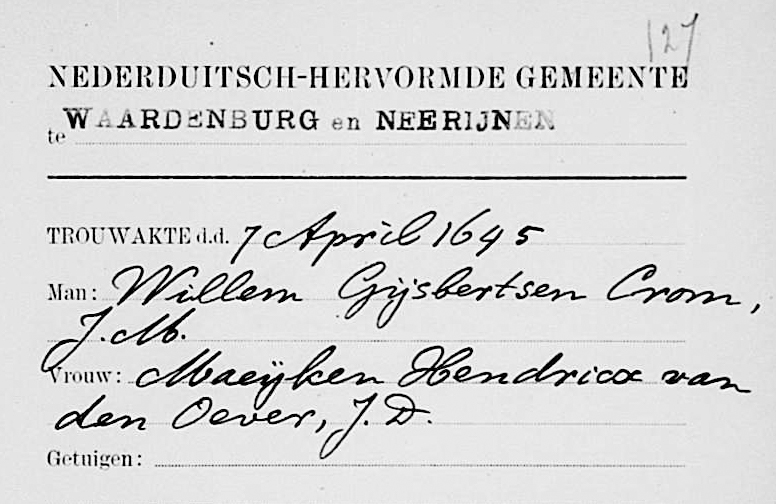
Willem Gÿsbertsen Crom was born about 1627 in Opijnen, Gelderland, Netherlands, some trees show him being born in Pijnacker, Zuid Holland (South Holland), Netherlands. He died sometime between 1656 and 1659 (after the birth of his last child and most likely before Maijke conceived her first child with Jan Joost which was about spring 1659) in Pijnacker, Zuid (South) Holland, Netherlands. Pinacker is east of the Tiererwaal district, not far from The Hague. I’ve not found any records to confirm these assumptions.
The Crom Children
The children of Willem Gÿsbertsen Crom and Macyke Hendricks.
There is much controversy regarding the Crom children, who they were and their ages. I have done a separate post on The Crom Children to read my take on who they were and their ages when arriving in New Amsterdam.
- Gÿsbert Willems Crom
- Lysbet Willemsdr Crom
- Henry Willems Crom
- Geertje Willemsdr Crom
Jan Joosten Van Meteren and Macyke Hendricks Child
Jooste Janse Van Meteren
also called John Van Metre, John of New York, and John the Indian Guide and Trader.
Born: About Feb 1660 in Tielerwaard, Gelderland, Netherlands.
Died: Before 1776 – time and place of death unknown. The last record showing Sara as his wife (not widow) was in 1709. There is a record of John Van Matre in Virginia in 1726, but that may be his son Jan Joosten, and also called John Van Metre.
Married: 12 Dec 1682 Sara DuBois in Wiltwyck, Esopus, New Netherlands (now Kingston, Ulster County, New York).4
Find A Grave: Memorial #184623335 burial details unknown.
Note: John and Sara had a very adventurous life. This is the ancestor I will follow. His post is Coming Soon.
Sara DuBois
daughter of Louis DuBois and Catherine Blanchan
Baptized: 14 Sep 1664 in Wiltwyck, Esopus, New Netherlands (now Kingston, Ulster County, New York).
Died: 13 Jan 1726 in Salem, Salem County, New Jersey, Colonial America.
Find A Grave: Memorial #79887606 shows burial at Old Hurley Burial Ground, Hurley, Ulster County, New York, USA. She died in Salem, New Jersey and it’s impossible, but unlikely that her body would have been returned to New York. .
The Tielerwaad, New Netherlands
The Tielerwaad, New Netherlands
There is not much known about Jan Joosten prior to him coming to America, but we can speculate to some extent. We do know he was born in Tiel, Tielerwaad, Gelderland, New Netherlands and probably lived there until he immigrated to America in 1662.
The Tielerwaard is a region in the Dutch provinces of Gelderland and Zuid-Holland (South Holland) and is part of the Betuwe. The Betuwe region consists of three parts: the Over-Betuwe (Upper Betuwe?); the Neder-Betuwe (Lower Betuwe) and the Tielerwaard. The Tielerwaard traditionally refers to that part of the Betuwe, in the Dutch province of Gelderland, which is bordered to the north by the river Linge and to the south by the Waal. In the east it passes through to Tiel; downsteam in the west, the historic core of Gorinchem just fell outside. Since 1986 the Tielerwaard village of Dalem has belonged to the South Holland municipality Gorinchem and is, due to the eastern expansion of the city, also part of the city of Gorinchem in the Tielerwaard.
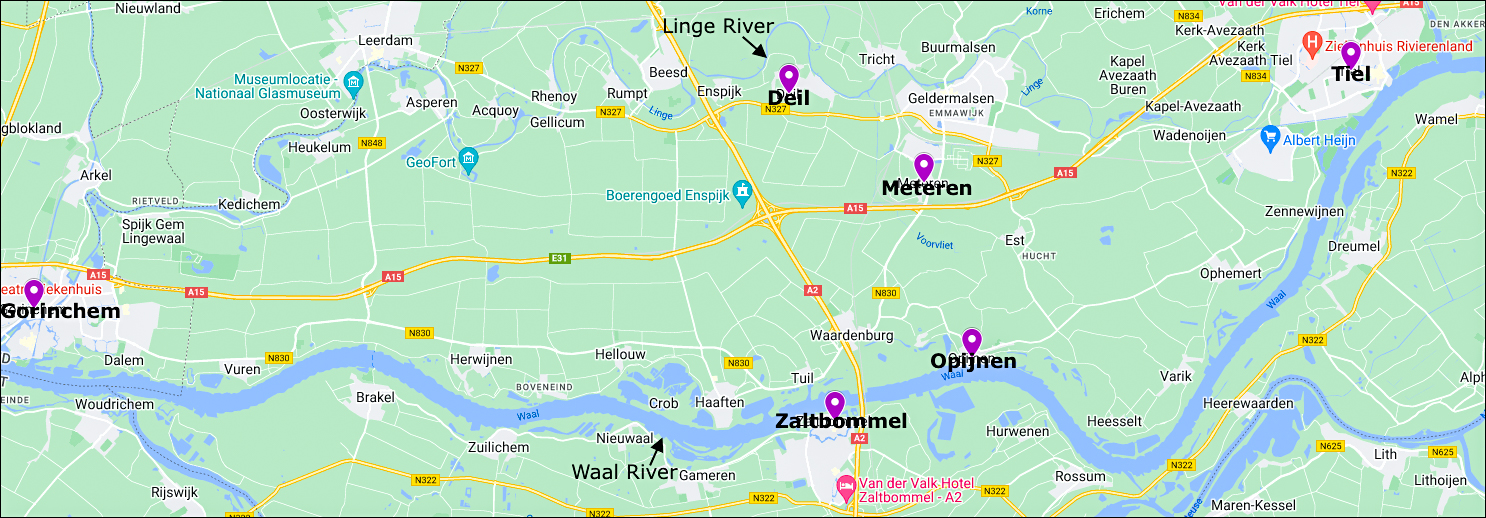
His family would most likely be impacted by the wars that were going on up and until 1648 when he was about 18 years old. His parents would have lived in this environment their whole lives up until that point. There was the Dutch Revolt (Eighty Years War) 1566-1648 where the Dutch rebelled against the Spanish Rule for both political and religious reasons; and The Thirty Years’ War 1618-1648), which was one of the longest and most destructive religious wars in history, between various Protestant and Catholic states in the fragmented Holy Roman Empire.
Despite the wars going on, The Dutch “Golden Age” spanned the 17th century, in which Dutch trade, science, military and art were among the most acclaimed in the world.
Jan Joosten was a member of the Dutch Reformed Church. The Dutch Protestant work ethic, based on Calvinism, promoted thrift and education and we know that he was literate, being able to read and write and was noted as a tutor to his children, grandchildren and others.
Soon after arriving in America he appears to be a Skipper of a Sloop / Yacht, so must have learned this trade, living on the Tilerwaard waterways. The Tielerwaard was an area surrounded by the rivers. The water ways would be a large part of life, including transportation, and he most likely interacted with many of the area inhabitants.
New York
Jan Joosten and family immigrated to the “New World” in 1662, arriving in New Amsterdam, now New York and settled in Wiltwyk, what is now Kingston, New York. During his lifetime, New York would be controlled by the Dutch, then the English, then the Dutch again, then the English. The names of many communities also changed. Below is a short timeline of events and the place names that will show up in documents:
- 1614 – The Dutch settle on Manhattan Island
- 1623 – Dutch fort built
- 1624 – New Amsterdam is founded by the Dutch West India Company.
- 1626 – Lenape sell Manhattan Island to the Dutch.
- 1652 – City of New Amsterdam incorporated.
- 1664 – September 24 – New Amsterdam is ceded by Peter Stuyvesant to England who renamed it New York after James, Duke of York.
- 1667 – New Netherlands becomes part of England per Treaty of Breda.
- 1673 – The Dutch regain New York, renaming it “New Orange” (from February 1673 to November 1674). Other place names are changed.
- 1674 – The Dutch cede New Netherlands permanently to England and many place names change again.
Dutch Rule: 1626 to 1664
English Rule: 1664-1783
Dutch Rule: February 1673-November 1674
England Rule: 1674 until American Revolution.
Town Names will show up in a variety of documents. The following are relevant places:
- New Netherlands, now as far north as current Albany, New York; as far south as to include New Jersey; to Cape Henlopen, Delaware; and as far east as the Connecticut River.
- Fort Orange, New Netherlands, now Albany, New York
- New Amsterdam, New Netherlands, now Lower Manhattan, New York
- Fort Amsterdam, New Netherlands, now Lower Manhattan, New York
- Esopus, New Netherlands, now Ulster County, New York
- Wiltwyk, New Netherlands, now Kingston, New York
- Nieuw Dorp, New Netherlands, now Hurley, New York
- Beverwijck, New Netherlands, now Albany, New York
- New Orange, New Netherlands, now New York, New York
- Swaenenburgh, New Netherlands, now Kingston, New York
Jan Joosten & Family Immigration to America
Jan Joosten and wife immigrated to America on the ship “de Vos” leaving Amsterdam, Netherlands. “D’vos sailed on 31 August 1662, arrived on 14 November 1662 under Captain Jacob Jansz Hays.”
“35-41 Jan Joosten from the Thillerwaerd, and wife and five children ages 2 1/2, 6, 9, 12 and 15 years” 5
The names of the wife and children were not noted in the ship manifest, but we know that the wife was Macyke Hendricx. About the children, you will find various arguments on this subject, including who the five children were, whether Jan Joosten was their biological father, in what order they were born, and what became of them. It’s pretty much accepted that four of the children were Gysbert Crom, Lysbeth Crom, Geertje Crom and Joost Janse Van Meteren. Some believe that three of the children are the children of Willem Crom and two are the children of Jan Joost. Others believe that four of the children were Crom children. The fifth child’s name is a matter of discussion with a variety of names. I’ve come up with my own theories and why which i’ve covered in my Crom Children Post.
The reason for their immigration is unknown, but in 1656 Holland took control from the traders and supported the Dutch Colonization of the New World offering free passage to the New Netherlands colony. It was good timing for the family, as in 1664 the Bubonic Plague hit Holland killing 200,000 people.6
The family and their belongings were carried up the Hudson River in a yacht belonging to the Governor-General, Petrus or Pieter Stuyvesant), to settle in Wiltwyck (now Kingston) Ulster Co. N.Y.7
There is also evidence that Jan Joosten himself must have been in America at an earlier date because in 1661 he was appointed, together with Albert Heymanse Roose and Jan Gerritsen, to serve on a committee to superintend the enclosing of the new village of Niew Dorp (Hurley) in the present county of Ulster, New York.8 Did he come over on his own to evaluate the conditions and opportunities before bringing over his family?
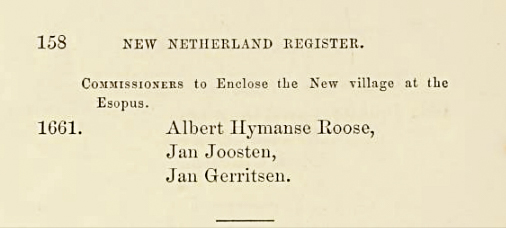
Wiltwyck, New Netherlands 1662-1664
Our pioneer ancestors lived in a time when they had to be self-sufficient. The community was very important to survival and this was a community of many cultures, including Dutch and French immigrants. They continued to speak their native languages but had to learn how to communicate with their neighbors, including the local Indians.
By 1662, the lands in the neighborhood were successfully cultivated, and hamlets formed at Wiltwyck (now Kingston) and Niew Dorp (now Hurley).
I would assume that the family had one of the lots in the expanded section of the Kingston Stockade, added on in 1661, (based on the date they arrived). They would have had time to build their one room 20 x 20-foot home and become established in the community.
Find more about Wiltwyck/Kingston along with details about the Kingston Stockade on my post Esopus / Wiltwyck / Kingston, New York early History.
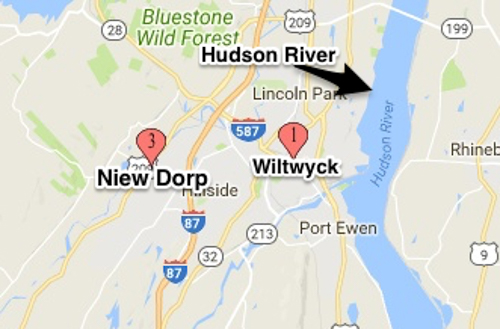
Jan Joosten Court Records 1663
There are several court records where Jan Joosten is showing up as a Skipper and owning his own sloop/yacht along with a partner, Lucas Andriessen. The following are interesting excepts giving us an insight to what he was doing in 1663 in Wilwyck and vicinity.
Tuesday january 9, 16639
Jan Joosten, pltf. v/s Abraham Pietersen, miller, deft. Pltf. says, he sold to Tomas Jansen Mingael, defts. son in law, a yacht, on which there is still to be paid one thousand and fourteen guilders in sewant and requests that the yacht may be sold to obtain his pay from it. Deft. says, there is no money to pay and if the Magistrates think fit, that the yacht may be sold for the best advantage of the widow.
Tuesday January 16, 166310
Jan Joosten entering requests, that he may be allowed to take back the yacht he sold Tomas Jansen Mingael, as it is not yet paid for. The W. [Wiltwyck] Court inform Jan Joosten to have yet some patience.
Tuesday, January 23, 166311
Lucas Andriesen and Jan Joosten, plaintiffs v/s Abraham Pietersen and his daughter, defendants., deliver in a petition. Plaintiffs produce papers. The W. [Wiltwyck] Court undertake to consider the case.
Saturday, January 27, 166312
Jan Joosten entering requests by petition, that he may take and resume the yacht, which he and Lucas Andriessen sold to Tomas Jansen Mingael and which yacht is bound for the payment—at the price at which it was sold to him; and to receive for the use, wear and tear of said yacht and tackle whatever arbitrators to be selected by the Court and conversant therewith shall adjudge to be proper, taking into calculation, what has been paid thereon. Apostille—Petitioner is ordered to have his eye on the yacht, until further disposition be made in the matter.
Friday, February 23, 166313
Jan Joosten, entering requests by petition as well in his own name as in that of his partner Lucas Andriessen, that they may resume as their own by default of payment, the yacht called The Flower of Gelder, which they, the petitioners, sold to Tomas Jansen Mingael and is pledged for the payment to them and that they shall receive for the use, wear and tear of said yacht and its appurtenances, what arbitrators, conversant therewith and to be chosen by the Court, shall deem a proper compensation, returning what has been paid on the yacht by the above named Tomas Jansen. Jan Joosten is asked, if he will take back the yacht at the price, for which it was sold, on condition of returning what was paid thereon? Answeres No—Offers to take it back for what now remains to be paid on it. Burgomastes and Schepens taking into consideration Jan Joosten’s offer and that it is sixty five guilders more, than the yacht is valued at by appraisers, appointed thereunto by the W:[Wiltwyck] Court, grant Jan Joosten and his companion Lucas Andriessen to resume the aforesaid yacht for what remains to be paid thereon, and to use it as their own.
March 13, 166314
Burger Horizon, pltf. V/s Jan Hackens, deft. Pltf. Demands restitution of a kedge, which he made for Tomas Jansen Mingael for three beavers; or payment of the three beavers, as it is not paid for. Deft. Produces an inventory of goods, which he bought on the yacht of Lucas Andriessen and Jan Joosten. Pltf. Says that Lucas Andriesen and Jan Joosten admit, the Kedge in question is unpaid for. They therefore had no right to sell it. Lucas Andriessen and Jan Joosten appearing say, there was an anchor with the yacht, where they sold it to Thomas Jansen and that Thomas Jansen sold the anchor. They therefore retained the kedge instead. Admit they knew the kedge was paid for. Burgomasters and Schepens decree, whereas Lucas Andriessen and Jan Joosten admit having been aware, that the kedge was not paid for, which they sold with other property and the yacht to Jan Hackens, that they shall satisfy and pay Burger Jorisen for the same.
March 13, 166315
Jan Hackens, pltf. V/s Lucas Andriessen and Jan Joosten, delfts. Pltf. In default.
Tuesday, March 20, 166316
Jan Joosten appears in Court representing that on the anchor sold with his yacht to Tomas Jansen Mingael there remains something yet to be paid by Eghbert Bennick, who bought the anchor from the above named Tomas Jansen, requesting that he may have his guarantee on the same for the kedge, which he must pay Burger Jorisen for. Burgomasters and Schepens having considered the request and read the deed of sale between him and Tomas Jansen Mingael for the yacht and appendages, find the aforesaid anchor bound to him as depending on the yacht; therefore decree by plurality of votes, that Jan Joosten shall hold his guarantee on the anchor for three beavers and no more.
Tuesday, June 12, 166317
Jan Joosten, Plaintiff v/s Eghbert Benninck, defendant. Defendant in default.
Monday, October 29, 166318
Hendrick Hendrickzen Obe, pltf. v/s Jan Joosten, deft. Plaintiff in quality as tutor for the surviving children of Gerrit Hendricksen van Harderwyck, says he sold to defendants wife a house and lot belonging to Barent Cruytdop, sold by execution conformably to deed and bought by Gerrit Hendricks afores and sold on the same conditions according to deed of sale made therein, but not signed and that the defendant accepted the sale. Defendant says, he knew not, but the lot on the Stand situate behind the house lot, belonged thereto; and if such did not belong to it, he does not hold to the bargain; also that another has some claim on the lot lying in the rear of the house. Burgomasters and Schepens order the Road Surveyors to inspect the premises in presence of Burgomaster Oloff Stevensen van Cortlant.
The Second Esopus War 1663
On June 7, 1663, while many of the men and older children were away from the villages working in the fields, the Esopus Indians raided and burned the villages of Niew Dorp (Hurley) and Wiltwyck (Kingston). This was the beginning the The Second Esopus War.
The Indians carried away captive the wife and two children of Jan Joosten, the wife and three children of Louis Du Bois, and two children Mattheus Blanchan and the wife and one child of Antoine Crispell. They were not rescued until 3 months later. Names of the children were not listed, but the following are the most likely taken:
- Macyke Hendricks, wife of Jan Joosten and two of their children [most likely: Geertje Crom, 7 and Joost Janse, 3 1/2].
- Catherine Blanchan, wife of Louis Du Bois and daughter of Mattheus Blanchan, and three of her children [most likely: Abraham, 6; Isaac, 3; and Jacob, 1 1/2. Stories passed down say baby Sara Du Bois was one of the children, but she was not baptized until 14 Sep 1664, and typically children were baptized shortly after their birth, so I doubt that Sara was one of the children. Joost Jans will later marry Sara]
- Maria Blanchan, wife of Antoine Crispell and daughter of Mattheus Blanchan, and one of their children [most likely their daughter, Maria, 1 1/2].
- Two young children of Mattheus and Magdelina Blanchan [most likely Mattheus Jr, 8 and Elizabeth, 12].
These specific families are important because the families will become connected when Joost Janse marries Sara Du Bois, daughter of Louis Du Bois and Catherine Blanchan and granddaughter of Mattheus and Magdelena (Joire) Blanchan.
Wiltwyck, New York 1664-1669
New Netherlands Surrenders to English
On August 27, 1664, four English frigates led by Richard Nicolis sailed into New Amsterdam’s harbor and demanded New Netherlands surrender. They got no resistance because numerous citizens’ request had gone unheeded for protection by a suitable Dutch garrison against “the deplorable and tragic massacres” by the natives.
In a list of inhabitants of Ulster County, New York who subscribed to the oath of allegiance, due to a change in the sovereignty for the country, between the 21st and 26th of October 1664 the name of Jan Joosten appears among them. After this date, frequent notice of him occurs upon the records of Kingston as a farmer, a skipper and a man of growing importance in civil and religious matters.
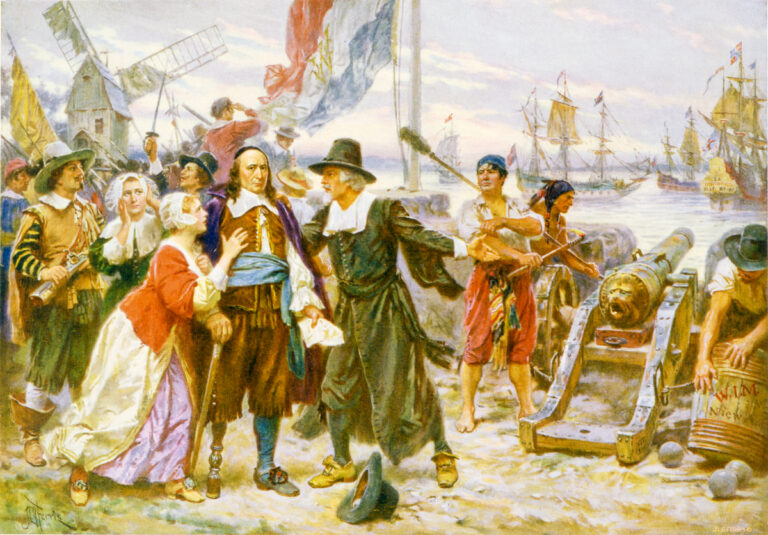
The Fall of Amsterdam 1664 by Leon Gerome Ferris19
Court Record 1664
Tuesday, January 22, 166420
Joannes Verveelen, Plaintiff v/s Joannes Nevius, as Vendu Master, Defendant. Plaintiff demands from defendant in said quality, payment of nine hundred guilders from the monies arising from the sale of the house of Baren Cruytdop sold by execution for the sum of seventy hundred and five guilders in seaman, by virtue of judgment and mortgage, with interest. Defendant says, that Gerrit Hendricksen van Harderwyck dec, [deceased], who purchased the house, had again offered it for sale to get the payment for it, but that he died when the sale was to take place, and that the said house was offered for sale by the executors and minors of the aforesaid Gerrit Hendricksen, but was not sold and is withdrawn by the executors for the benefit of the estate, as it could not bring enough; then that they had privately sold it to Jan Joosten’s wife, who brought to this City Hall the first payment being four hundred and ninety two guilders, eighteen stivers, eight pence. The executors appearing deny having offered the house at public sale;—then say, they sold it with consent of the secretary to Jan Joosten’s wife with Joannes Verveelens approbation. Burgomasters and Schepens decree, that as the plaintiff has the first mortgage, he shall draw the monies lying in consignment and the remainder up to nine hundred guilders, when the other monies shall come in, then not to enjoy any preference for interest, but to come in concurrence with the other creditors.
February 21, 166421
Jan Joosten is among those listed as promising to give on interest in behalf, and for the fortification of this City, Fl. [florens]10096.
Jan Joosten 1665-1668
In 1665, Jan Joosten was appointed as “schepen”, a minor judiciary position (justice), which, under the laws of New Netherlands, gave him jurisdiction in all civil actions under the sum of 100 guilders, but in cases above that sum they must be referred to the Director-General and his Council; he could also pronounce sentences in criminal cases, subject to appeal.22
I found Jan Joosten mentioned in many wills and testaments, assisting with inventories, as witness and deacon. One that was interesting was the will of Mr. Gysbert Van Imbroch with an impressive list of inventory. Jan Joosten not only assisted in the inventory, but purchased some, including:
- A copper kettle 40 guilders
- A bunker, as used by the savages, with a lot of nails, 28 gldrs, 10 st.
- 15 tankards and a pint tankard and 3 moulds for balls, 4 gldrs,10 st.
- An iron pot half filled with whale oil and an empty iron pot 10 guildrs
- Two Books: Beehive by Aldegonde, and the Chronicles of the Kings of England, 10 gldrs 5 st.”
Although many of the immigrants were illiterate, it is apparent that Jan Joosten could read and write.The van Meteren ancestors appear to be well educated.
He was in active demand to witness or serve as sponsor at the baptisms of many children at the homes of his friends and relatives; in some cases, the baptisms were celebrated “at Jan Joosten’s, in the presence of the whole consistory”23. The distinction was probably because he had been elected a deacon in the Reformed Dutch Church at Kingston by 1665.
During the trouble in Kingston (Wiltwyck?], caused by the offensiveness of the soldiers of the English garrison, Jan Joosten, with three other citizens, acted as mediators in the dispute and was able to resolve the disputes and thus prevented violence to lives and property.
The first use of the his name with the surname Van Meteren was in 1665. Jan Joosten Van Meteren shows up in the Ulster County, New York, Probate records for GERRETSEN, ALBERT, from Embderland. Testamentary disposition, dated Sept. 3, 1665, and written in Dutch: … signed by the testator, and witnessed by Jan Willemsen Hoochteylingk and Jan Joosten Van Meteren. 24 I didn’t find the use of the van Meteren Surname again until later in his life.
Marbletown 1669-1689
In 1669 Wiltwyck was officially changed to Kingston.
About the same time, 1669, the village of Marbletown, referred to as Mormer in many documents, was established and it was during this time that Jan Joosten acquired property in Marbletown.
April 1670
Marbletown, (also referred to as Mormer) is near the center of Ulster County, southwest of Kingston.
The village was established about 1669 and the boundaries were determined in April 1670.
From the Marbletown, New York website there is a bit of history:25
Although Marbletown was settled in 1669/1670, it did not receive its patent until June 25, 1703. The patent was granted by Col. Henry Beekman, Capt. Thomas Garton and Capt. Charles Brodhead in trust for the inhabitants. The trustees continued to be elected annually, until 1808.
In 1672, there were fifty-three houses on the site of the village of Marbletown, most of them log dwellings. The surface of the town was hilly upland, broken by valleys and streams. The Esopus flows through the northern part, while the Rondout runs through the southeast corner with a fall at High Falls.
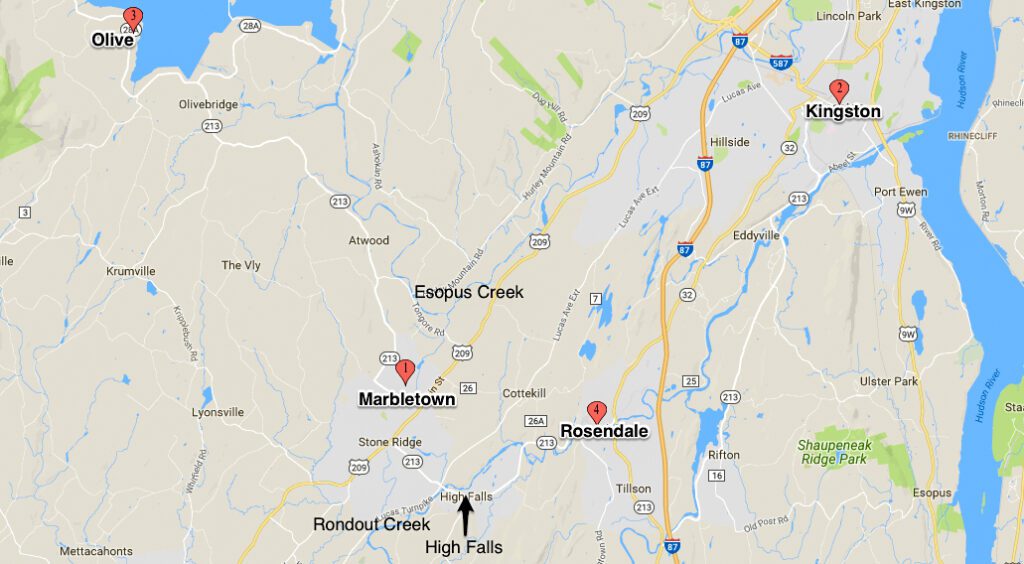
I assume that Jan Joosten was one of the first inhabitants and the owner of one of the fifty-three houses in the Town of Marbletown in 1672, as a grantee of a 30-acre plot in 1670.
In 1670, John Joesten [Jan Joosten], his son [Joesten [Joost Janse], Gysbert Crump [Crom] and Henry Crump [Crom] and other connected family, served as ordinary militiamen from Marbletown and Hurley, in the company commanded by Captain Henry Pawling. Louis DuBois and Anthony Crispell served from Hurley. The following excerpt is from the New York Colonial Muster Rolls, 1664-1775, Report of the State Historian of the State of New York:26 Keeping in mind, spelling wasn’t important. I’ve noted my assumptions in brackets for connected family.
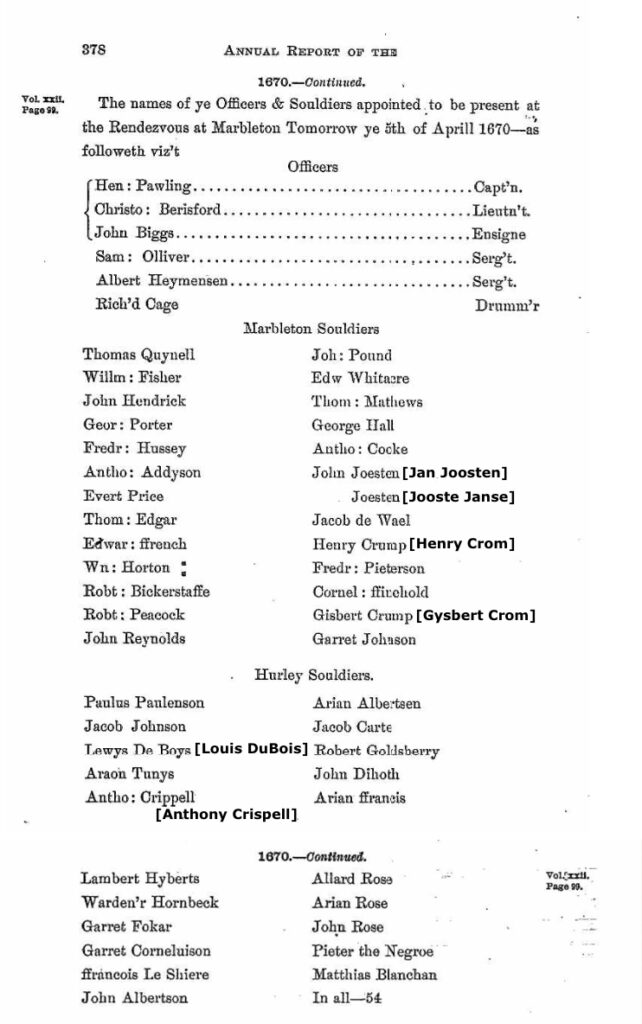
In the spring of 1670 Henry Pawling was again commissioned by Governor Lovelace together with the Governor’s brother, Captain Dudley Lovelace, Jacques Cortelyou, William Ikeman and Christopher Beresford to proceed to establish the boundaries of the new towns, and lay out and define the lots of the new villages and make the necessary allotments and grants thereof. This commission met at Kingston, March 10th, 1670, and adjourned April nth. During the sessions, they designated the boundary lines of Kingston, Marbletown and Hurley, divided the lands in lots, distributed them among the soldiers and gave the necessary grants therefor.27
Records show that Governor Lovelace deeded a 30-acre lot in Marbletown, New York to Jan Joosten Van Meteren on March 30, 1671. And a confirmation, October 11, 1671 of a thirty-acre lot of ground in Marbletown. Most likely the “lots” designated in 1670. Also of note, the surname Van Meteren was used in this record.28
April 5, 1672
Jan Joosten’s granddaughter, Jannetie (daughter of Joost Adriaensen and Lysbedt Willemsen [Crom]), was baptized on April 5, 1672. The witnesses were: “Jan Joosten, Gysberdt Crom, Maeycken, wife of Jan Joosten”.
July 27, 1672
On July 27, 1672, included in the list of volunteers to repair the fort, I found Jan Joosten, Mattie Blansjan and Lowies DuBois.
October 6, 1673 & August 14, 1674
Jan Joosten was selected, October 6, 1673, as one of the two magistrates of Marbletown, along with Jan Broerson. Hurley and Marbletown under English rule29. Louis DuBois and Roelof Hendricksen were selected as the two magistrates for Hurley. Jan continued in that civil office until the return of Dutch supremacy, in 1675, when Governor Colve reappointed him to serve for another term.
Jan Joosten, is again listed in the Muster Rolls as “Jan Joosten, barg’ln” as a Cadet, 30
The following was also found31
October 6, 1673
Gentlemen:
Herewith goes the election of the Magistrates and Militia officers of the towns of and Marble, who shall have to be sworn into their respective offices by Ensign Vos, who is ordered to stop at the Esopus, on his way down, for that purpose. As regards the nomination for Schout, whereunto, among others, is nominated William Beeckman, who resides and is in office here and also declines accepting the appointment; therefor have I deemed it necessary to recommend you and the other inhabitants of Swenenburgh to nominate, by plurality of votes, another proper person as Schout, in the place of said Beekman, and to send such nomination other by the first opportunity; whereupon relying, I shall remain,
Your friend,
A. Colve.
Fort Willem Hendrick,
6th October, 1673.
The above letter is sent to the inhabitants of Swenenburgh and those of the Towns of Horly and Marble.
From the nomination by the inhabitants of the Town of Swaenburgh [Kingston], the Governor selected for the next year as follows:
For Schepens:
Cornelis Wyncoop, Wessell Ten Broeck,
Roeloff Kierstede, Jan Burhans
VOLUME XXIIL
For Militia Officers:
Captain, . . . . . . . . Mathys Mathysen
Lieutenant, . . . . . Jan Willemsen
Ensign, …….. Mathys Barentsen
For Magistrates of the Towns of Holy and Marble:
Louis de Bois, Jan Joosten, and
Roeloff Hendricksen, Jan Broersen.
For Militia Officers:
Captain . . . . . . . . Albert Heymans.
Lieutenant, . . . . . Jan Broersen
Ensign . . . . . . . . . Gerrit Adriaensen.
And for Secretary of the Court of Swaenenburgh, Horly and Marbletown, William Lamontagne, who hath also taken the oath as Secretary.
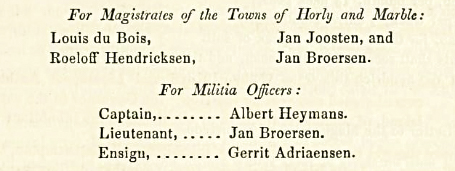
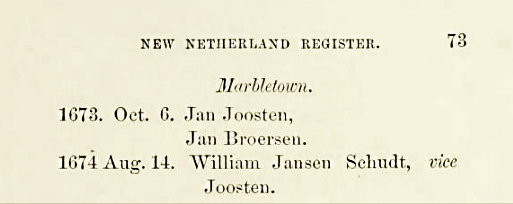
1674 The English regained the Country
- 1667 – New Amsterdam surrenders to England and they rename it New York.
- 1673 – The Dutch regain New York, renaming it “New Orange” (from February 1673 to November 1674).
- 1674 – The Dutch cede New York permanently to England and name changes back to New York.
March 10, 167432
Schout, Burgomasters and Schepens being assembled Colegialiter in the City Hall of the City of N:Orange on the 10th March A[o] 1674, having sent for the skippers and barquiers of this City and these appearing, they are informed of the order of the Honorable Governor General, that no more than two sloops shall go at once to Willemstadt and Esopus and one to South River, and that alternately, according as it shall be determined by lot; also that they, the skippers, shall not convey any passengers hence without passport.. Whereupon said skippered answered as follows:—
Skipper Kip answers, that he thinks it better, that whenever the sloops depart in their turn by lot, according to the Governors order, what they then earn shall be put in a common fund and every one shall then draw his share out according to the size of his sloop.
Frederic Hendrike: and his partner Dirck Francen agree with the above opinion of skipper Kip.
Hendrick van de Waater the same advice as above.
Claes Lock, the same as above.
Abraham Jan, carpenter, agrees with the above opinions.
Jan Schouten answers, that the small sloops ought to be allowed to make one voyage for one of the big ones.
Thomas Lewis is satisfied with what the Governor and Council decree.
Jan Jansen Moll agrees with the majority.
Abraham Lubbertsen the same opinion as Skipper Kip above.
Jacob van de Water agrees with the majority.
Dirck Smith requests, that whoever is ready first may make a trip.
Jan Joosten and Lucas, that the first ready may make a trip; if not, that they are content according as the Governor conclude and determines.
The Schout, Burgomasters and schepens of this city of N. Oraange having presented to the Honorable Governor General the answers of the skippers and barcquiers of this City regarding the sailing alternately according to his Honors last order, His Honor has resolved and ordered that said skippers and barcquiers shall, according to the majority of their opinions, sail in common stock, from which common fund each of them shall earn and draw out his share according to the size and proportion of his vessel at the end of the aforesaid alternating time; and said skippers and barcquiers shall in sailing regulate themselves according to the Honorable Governor Generals order made herein.
Done in the City Hall of the City N:Orange on the 15th March A[o] 1674.
March 26, 1678
On March 26, 1678, in the Will of Everdt Parys, of Hurly, “Maycken, the wife of Jan Joosten”, is acknowledged as being owed 1 schepel of wheat.
October 13, 1678
On October 13, 1678, their grandson, Willem, son of Lysbet Willems Crom and husband Joost Adriaense, was baptized. Sponsors were: “Jan Joosten, Gysbert Crom and Laurentia Van de Kellenaar.”
February 9, 1679
On February 9, 1679, their grandson, Gysbert, son of Gysbert Crom and his wife Geertie Van Vliet, was baptized. The witnesses were: Gerrit Gysbertse, Dirck Aryensse Van Vliet and Machtelt Van Vliet.
July 16, 1680
On July 16, 1680, Jan Joosten transferred [and held the mortgage?] to Henry Pauling, certain land. Paid Apr. 25, 168333
December 16 1681
From the Probate records of Ulster County, N.Y. wihich sets forth the testamentary disposition of Jan Joosten Van Meeteren dated Decemeber 16, 1681, it develops that Joost Janse was the elder son [eldest biological son] and, according to the provisions therein, received the heir-at-law’s usual double portion. The following is an excerpt:34
Joosten, Jan, van Meetern.
Testamentary disposition, dated Dec. 16, 1681, and written in Dutch.
“Wife Maycken shall retain full possession (of the estate). She consents that the survivor shall possess everything, lands, houses, personal property, money, gold, silver, coined or uncoined. After their decease, the property to be inherited by their children, Joost to have one half of the entire estate first. Joost and Gysbert to have the land at Marbletown, Joost one half, and then the other half to be divided between them. Geertie Crom to have the land at Wassemaker’s land. Children of Lysbeth, deceased, to have their portion, in money, from the other children.
Benjamin Provoost Jan Joosten
Leveryen Ten Hout Maycken Hendrix (her mark)”
Liber VI., part A., page 28. T.D.R., Liber 2, p..616
There are several things I noted from this document:
- Jan Joosten used a surname – Van Meeteren
- As mentioned above, it is obvious that Jan Joosten is literate.
- Apparently Maycken was not literate, as she signed with her “mark”.
- They appear to be of some means, mentioning multiple properties (Wassemaker’s land [in Hurley] and land [30 acres] in Marbletown), money, gold and silver. At this time, I also believe they had a “lot” in the Kingston Stockade, although I didn’t find when they acquired it, I did find later on when they deeded it to Jan Jansen on Nov 1, 1683.
October 1682
Jan Joosten is named as justice of the peace for Esopus and was present at the Court of Assizes, in New York, on October 4, 5 and 6, 1682.
Sometime shortly before October 17, 1682, their son-in-law, Joost Adriensen died. Jan Joosten was appointed administrator and tutor to the children:35
On 17 October 1683, Jan Joosten was appointed administrator and tutor to the children of Joost Adriensen of “Boswick upon Long Island” and arbitrator in proceedings regarding the sale of some land in Hurley, which had been sold to Derick Schepmoes by Joost Adriensen in his lifetime. Joost Adriensen was the husband of Elizabeth [Lysbeth] Williamsen Krom [Crom] Macyke’s daughter.
November 1, 1683
As previously stated, although I couldn’t find record of Jan Joosten being allocated a lot in the Kingston Stockade when they arrived in 1662 [I assumed they acquired a lot at that time], there is record of him transferring and mortgaging a lot in the Kingston Stockade to Jan Jansen on Nov 1, 1683,
1883-1888
The following records were found in the Old Dutch Church, Kingston records between 1683 and 1688:36
On December 9, 1683, Henric, son of Gysbert Crom and Geertie van Vlied was baptized. The sponsors were Johannes Weecksteen and Mayken Hendrix.
On April 26, 1686, Rebbecca, daughter of Joost J. van Meteren and Sara Du Bois was baptized. Witnesses were Gysbert Crom and Catryn du Bois. [Note the van Meteren surname was used.]
On July 25, 1686, Elysabeth, daughter of Jan Hamel and Geertie Crom was baptized. Sponsors were: Jan Joossten and Jannetie Molenaar.
On Mar 5, 1688, twins Zacharias and Lysbeth, children of Geesberth Krom and Giertje Van Vliet were baptized. Sponsors were: Jan Hamel, Hendrick Arisen, Jan Happort, Mecktel Van Vliet and Jannetje Arise.
On Aug 26, 1688, Jan, son of Jan Hamel and Gerithje Krom was baptized. Sponsors were Jan Jooste, Jooste Jansen] and Geertje Krom
On 2 March 1688, Lysbeth, daughter of Jooste Jansen and Sara du Bois was baptized. Sponsors were David du Bois and Janneken Meulenaer.
September 1, 1689
With the regaining of the Country by the English (in 1674), the inhabitants were again required to swear allegiance to their new overlords, so it is recorded that Jan Joosten once more performed this act of fealty September 1, 1689 in Ulster County.37 His name was spelled John Joston. His son Jooste Janse also appeared with the spelling Jost Jansin. Gisbert Crom was listed as on appearing.
Lazy Point, Burlington County, West Jersey
By 1692 Jan Joosten and his son Josst Janse are showing up in New Jersey. It’s hard to determine who and why they relocated to West Jersey. I suspect that as an Indian Guide, that Joost Janse “spied out” the land in his travels and discovered est and West Jersey. We cover more on Joost Janse in a separate post, but they are both showing up in New Jersey records. We know that the two families were there as early as 1689. Joost Janse and Sara Du Bois’s son Isaac was born in West Jersey in 1692. But they had returned to Marbletown by 1695 when their son Henry was born.
I will also be adding a post on New Jersey and the areas where the family is found, but here I’ll just cover the events impacting Jon Joosten.
In 1695, in partnership with his son-in-law, Jan Hamel, who had married Geertje Crom (aka Gertrude and Girty Jans) in 1682, Jan Joosten [1] appeared in West Jersey, where they jointly bought on October 18, 1695, from Edward Hunloke, the deputy Governor, of Wingerworth, Burlington County, who was Deputy Governor under Dr. Daniel Coxe, a plantation of 500 acres located at Lassa, or “Lazy” Point on the Delaware River, the present city of Burlington. The record is as follows:38
1695 Oct. 18. Do. [Deed] Edward Hanloke (as above) to John Joosten and John Hammel, both now or late of Sopus, N.Y. yeoman, for a plantation with 500 acres at Lessa or Wingerworth Point [Lazy Point], Burlington, Co., in town bounds, of which 100 a. were bought of Thomas Bowman March 24, 1692, 100 a. of Sheriff James Hill Febry. 2, 1693-4, 145 1-2 a. of George Hutcheson Dec 4, 1689. 35 a. of Helna Skene July to Last, 1191/2 a. being part of Son a. bo’l of James Reade and wife Sarah April 4, 1689. p 477
1695 Oct. 19. Do. Mortgage. John Joosten and John Hammel, both of Wingerworth Point, yeomen, to Edward Hunloke of the same place, merchant, on the preceding 500 acres. 477.
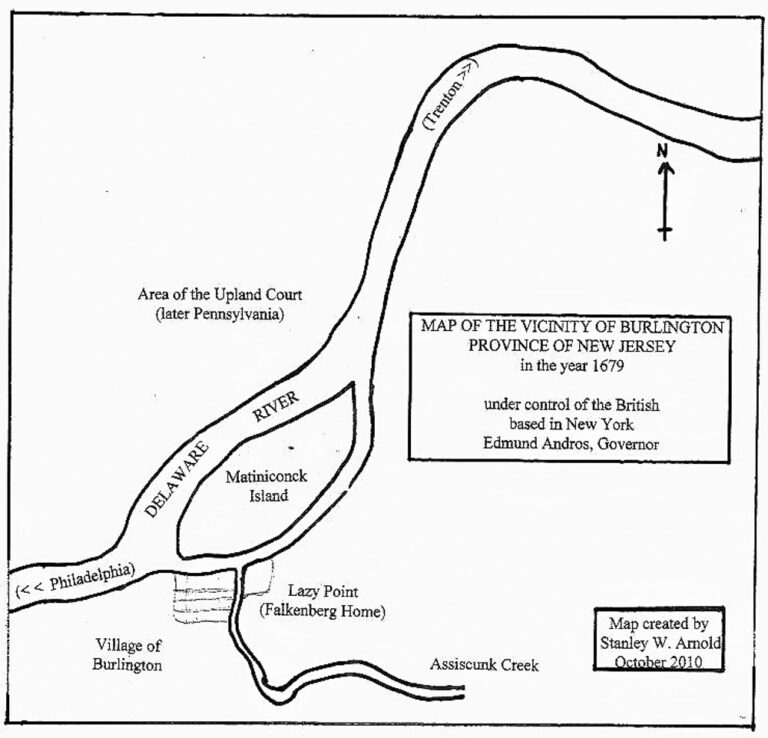
On 5 June 1696, Jan Joosten, late of Burlington Township, executes a power of attorney to William Wood, of Chesterfield Township, Burlington County, authorizing the latter to collect his debts. as follows:39
1696 June 5. Power of Attorney. John Joosten, late of Burlington Township, to William Wood of Chesterfield Township, to collect debts. p 594
The inference here is that Jan Joosten was not in the area during this time. Perhaps he returned to Marbletown to attend to family matters. He is still not present in August 1697 when William Wood appears in court on behalf of John Joosten:40
At a Special Court of Pleas held the 27th day of August 1697….
“John Joosten and John Hammel Plaintiffs Edward Hunloke Esqr. Defendant the plaintiffs and defendants Appeare (viz) William Wood appears for John Joosten.” “The defendant requires a sight of the deed given by the defendant to the Plaintiff which upon the Defendants Assumpsitt to the Bench to redeliver the said Deed Againe; is delivered to him the said defendant to peruse till after dinner. Post Meidie the defendant delivers the deed Againe And proceed no further to tryall.”
Joint ownership in Lassa (Lazy) Point, was held by Jan Joosten and Jan Hamel until May 1, 1699, when, by deed of conveyance, Jan Joosten deeded the property to Jan Hamel as follows:41
1699 May 1. Do. [Deed] John Joosten of Marbletown, Ulster Co, N.Y., to John Hammell of Lazy Point, Burlington, for his share of the plantation, out of Edw. Hunlike (supra, p 632).
p 653
As noted,Jan Hamel was the husband of their daughter, Geertje Crom. This may have been about the time that Jan Joost began transferring his property to his heirs. He would have been about 69 years old at this time.
Somerset County, New Jersey
In 1700, we find Jan Joosten [1] acquiring land in Somerset County of East Jersey on the Raritan River.
Somerset County is one of America’s oldest counties, and is named after the English county of Somerset. The area was first settled in 1681, in the vicinity of Bound Brook, and the county was established by charter on May 22, 1688. Most of the early residents were Dutch. For much of its history, Somerset County was primarily an agricultural county.
Jan Joosten appears in the Province of East Jersey as an individual purchaser of lands in Somerset County. The lands were designated as unappropriated and un-surveyed tracts, lying contiguous and located on the South Branch of the Raritan River, which was in the vicinity of the present town of Somerville. The 1,835 acres, was made up of four parcels as follows:42
13 Sept 1700. Deed. Co. Andrew Hamilton, Governor of East Jersey, and wife Agnes to Jane Joosten of Marbletown, Ulster Co. NY., yeoman [a man holding and cultivating a small landed estate; a freeholder], for the following tracts:
-
835 acres, S.E. the Raritan R.,S. W. John Campbell, N.E., John Drummond of Londine, N.W. sun surveyed, (patent of June 1, 1686); [adjoining lands of John Campbell and John Drummond]
-
250 a. (patent of Nov. 4, 1687) E., the South-branch of Raritan k., S. grantor, N. Hendrick Coursen, W. unappropriated; [adjoining lands of Hendrick Coursen]
-
250 a. (patent of Feb. 5, 1697-8); E. said South branch, S. grantor, N. Hendrick Cozrwsen, W. un-surveyed, adjoining the preceding;
-
500 a. [acres] (patent of Feb. 3, 1687-8), S.E. said branch of Raritan R., S. W. Melford’s land, NW. and N.E. unappropriated. [adjoining William Medford and waters of the South Branch.] p 198
The plantation aggregated 1,835 acres. It consisted of broad and fertile meadows on the Raritan; and the locality was already partially seated by groups of Dutch and Scotch people from the Kill-Van-Kull and Perth, with a few French from Staten Island, who had come into this region about fifteen or twenty years before. [Kill Van Kull is a tidal strait between Staten Island, New York and Bayonne, New Jersey.]
On September 13, 1700, there is a record of Jan Joosten being at Piscataway (Perth), where he probably went to meet the Governor and obtain his grant.

Jan Joosten's Will
The actual place of residence of Jan Joosten at this period is unknown, but in the New Jersey Calendar of Wills is found the date of the filing of the inventory of the personal estate of “Jan Joosten of ?,” dated June 13, 1706, marked Dutch. And reads as follows:
1706 June 13 (Dutch). Van Metere, John Joosten, of ?. Inventory of the personal estate, £235.14, incl. 6 negro slaves, a man, a woman and four children, £145; made by Jooris (George) van Neste and Hendreck Reinersen. Sworn to by John van Mater in Burlington.
It’s possible the “John van Mater in Burlington” is his grandson, John Van Metre. His cousins son was also called John Van Metre, but I doubt it would have been him.
The appraisers were neighbors to each other and were residents on the South Branch of the Raritan. In the same neighborhood were other Dutch residents, emigrants from Kingston, among whom were: Thomas and George Haal, Abraham de la Meter, Cornelius DuBois, Adrian Molenaur and Hendrick Traphagen; they were scattered along the main stem of the Raritan, at Three Mile [Franklin Park] and Six Mile [New Brunswick]. So perhaps we can ‘assume’ that his residence at the end of his life was in Somerset County.
Many webgens date his and Macyke’s death as June 13, 1706, but this was the date inventory for the estate was filed and I assume most of his property was disbursed to his heirs prior to his death. He most likely died shortly before this date. I found no evidence of when Macyke died, but it appears she died before Jan Joosten. He would have been about 76 years old at the time of his death.
“Jan Joosten Van Meteren was in every sense, an enterprising and influential citizen; a man of vision, initiative, culture and other fine and useful qualities, and in whom the people placed their matters of trust without fear of being betrayed or exploited.”43
Citations:
- Jan Joosten van Meteren baptism, Netherlands, Gelderland Church Records, 1405-1966, Film #007168687, Nederlands Hervormde [Dutch Reformed] Dopen [Baptism], Tiel, Image #29, retrieved from https://www.familysearch.org/ark:/61903/3:1:3QS7-89W2-33R5?i=28&wc=SMHQ-3TY%3A1292637101%2C346630802%2C347463901&cc=2038506 (Accessed 27 Jan 2023).
- Maijke Hendricx baptism, showing Hendrick Hendricx as her father and Lijsbeth Voet as her mother, retrieved from Archieven online at https://www.regionaalarchiefrivierenland.nl/archieven?mivast=102&miadt=102&miaet=54&micode=3198-1913&minr=9258849&miview=ldt (Accessed 27 Jan 2023).
- "Netherlands, Gelderland Province, Church Records, 1405-1966," images, FamilySearch (https://familysearch.org/ark:/61903/3:1:3QS7-89WK-7ZV1?cc=2038506&wc=SMH9-MNT%3A1292637101%2C347308701%2C347440501 : 22 August 2014), Nederlands Hervormde > Waardenburg > Fiches, Trouwen 1619-1747 > image 135 of 609; Gelders Archives, Arnhem.
- "Baptismal and Marriage Registers of the Old Dutch Church of Kingston, Ulster County, New York 1660-1809." Genealogical Publishing Co., Inc. Baltimore, 1980, page 506 #56. Online at Internet Archive: https://archive.org/details/baptismalmarriag00king/page/n7/mode/2up. (Accessed 4 Mar 2023).
- Jan Joosten and family ship manifest, retrieved from Immigrant Ships Transcibers Guild online at https://www.immigrantships.net/v10/1600v10/dvos16621114.html (Accessed 28 Jan 2023).
- New Netherland Institute, Exploring America's Dutch Heritage - website https://www.newnetherlandinstitute.org (accessed 27 Aug 2017)
- Steven Butler's Family History Website. Biographies. Jan Joosten Van Meteren (Abt. 1630-1706). http://www.watermelon-kid.com/family/bios/vanmeter1.htm (Accessed 02 September 2017)
- The Register of New Netherland; 1626 to 1674. By E. B. O'Callaghan, LL.D. J. Munsell, Albany, N.Y.MDCCCLXV [1865]. http://www.ramapoughlenapenation.org: (Accessed 23 June 2016).
- Records of New Amsterdam from 1653 to 1674. Minutes of the Court of Burgomasters and schepens Jan. 3, 1662 to Dec 18, 1663. Accessed online at FamillySearch.org at https://www.familysearch.org/library/books/viewer/117664/?offset=0#page=178&viewer=picture&o=&n=0&q= (Accessed 28 Jan 2023).
- Records of New Amsterdam from 1653 to 1674. Minutes of the Court of Burgomasters and schepens Jan. 3, 1662 to Dec 18, 1663. Published Under the Authority of The city of New York by The Knickerbocker Press MDCCCXCVII, page 183. Accessed online at FamillySearch.org at https://www.familysearch.org/library/books/viewer/117664/?offset=0#page=185&viewer=picture&o=search&n=0&q=(Accessed 28 Jan 2023).
- Records of New Amsterdam from 1653 to 1674. Minutes of the Court of Burgomasters and schepens Jan. 3, 1662 to Dec 18, 1663. Published Under the Authority of The city of New York by The Knickerbocker Press MDCCCXCVII, Page 186. Accessed online at FamillySearch.org at https://www.familysearch.org/library/books/viewer/117664/?offset=0#page=188&viewer=picture&o=search&n=0&q= (Accessed 28 Jan 2023).
- Records of New Amsterdam from 1653 to 1674. Minutes of the Court of Burgomasters and schepens Jan. 3, 1662 to Dec 18, 1663. Published Under the Authority of The city of New York by The Knickerbocker Press MDCCCXCVII, Page 191. Accessed online at FamillySearch.org at https://www.familysearch.org/library/books/viewer/117664/?offset=0#page=193&viewer=picture&o=&n=0&q= (Accessed 28 Jan 2023).
- Records of New Amsterdam from 1653 to 1674. Minutes of the Court of Burgomasters and schepens Jan. 3, 1662 to Dec 18, 1663. Published Under the Authority of The city of New York by The Knickerbocker Press MDCCCXCVII, Page 203. Accessed online at FamillySearch.org at https://www.familysearch.org/library/books/viewer/117664/?offset=0#page=205&viewer=picture&o=&n=0&q= (Accessed 28 Jan 2023)
- Records of New Amsterdam from 1653 to 1674. Minutes of the Court of Burgomasters and schepens Jan. 3, 1662 to Dec 18, 1663. Published Under the Authority of The city of New York by The Knickerbocker Press MDCCCXCVII, Page 209-210. Accessed online at FamillySearch.org at https://www.ancestry.com/imageviewer/collections/12896/images/dvm_PrimSrc000280-00757-0?ssrc=&backlabel=Return&pId=1503 (Accessed 29 Jan 2023).
- Records of New Amsterdam from 1653 to 1674. Minutes of the Court of Burgomasters and schepens Jan. 3, 1662 to Dec 18, 1663. Published Under the Authority of The city of New York by The Knickerbocker Press MDCCCXCVII, Page 211. Accessed online at FamillySearch.org at https://www.ancestry.com/imageviewer/collections/12896/images/dvm_PrimSrc000280-00757-1?ssrc=&backlabel=Return&pId=1504 (Accessed 29 Jan 2023).
- Records of New Amsterdam from 1653 to 1674. Minutes of the Court of Burgomasters and schepens Jan. 3, 1662 to Dec 18, 1663. Published Under the Authority of The city of New York by The Knickerbocker Press MDCCCXCVII, Page 217. Accessed online at FamillySearch.org at https://www.familysearch.org/library/books/viewer/117664/?offset=0#page=219&viewer=picture&o=&n=0&q= (Accessed 28 Jan 2023)
- Records of New Amsterdam from 1653 to 1674. Minutes of the Court of Burgomasters and schepens Jan. 3, 1662 to Dec 18, 1663. Published Under the Authority of The city of New York by The Knickerbocker Press MDCCCXCVII, Page 257. Accessed online at FamillySearch.org at https://www.familysearch.org/library/books/viewer/117664/?offset=0#page=259&viewer=picture&o=&n=0&q= (Accessed 28 Jan 2023)
- Records of New Amsterdam from 1653 to 1674. Minutes of the Court of Burgomasters and schepens Jan. 3, 1662 to Dec 18, 1663. Published Under the Authority of The city of New York by The Knickerbocker Press MDCCCXCVII, Page 326-327. Accessed online at FamillySearch.org at https://www.familysearch.org/library/books/viewer/117664/?offset=0#page=328&viewer=picture&o=&n=0&q= (Accessed 28 Jan 2023)
- The Fall of Amsterdam 1664 by Leon Gerome Ferris 1754, https://commons.wikimedia.org/wiki/File:The_fall_of_New_Amsterdam_cph.3g12217.jpg
- "The Records of New Amserdam from 1653 to 1674 Anno Domini," Vol. V. Minutes of the Court of Burgomasters and Schepens Jan. 8, 1664 to May 1, 1666, Inclusive, Edited by Berthold Fernow. The Knickerbocker Press for The City of New York. 1897.Pafe 8-9 https://www.ancestry.com/imageviewer/collections/12896/images/dvm_PrimSrc000280-00831-0?ssrc=&backlabel=Return&pId=1649 (Accessed 20 Feb 2018).
- "The Records of New Amserdam from 1653 to 1674 Anno Domini," Vol. V. Minutes of the Court of Burgomasters and Schepens Jan. 8, 1664 to May 1, 1666, Inclusive, Edited by Berthold Fernow. The Knickerbocker Press for The City of New York. 1897. Page 32 https://www.ancestry.com/imageviewer/collections/12896/images/dvm_PrimSrc000280-00843-0?ssrc=&backlabel=Return&pId=1673 (Accessed 20 Feb 2018).
- Smyth, Samuel Gordon. "The Origin and Descent of an American Van Metre Family", 20 Oct 1923. Lancaster Press, Inc., Lancaster, PA. page 15
- Baptismal and Marriage Registers of the Old Dutch Church of Kingston, Ulster County, New York 1660-1809. Genealogical Publishing Co., Inc. Baltimore, 1980. https://search.ancestry.com/search/db.aspx?dbid=20911 (accessed 21 Jun 2016).
- Ulster County, N.Y. Probate Records: https://archive.org/details/cu31924068180532/page/30/mode/2up?view=theater&q=Meteren.
- Marbletown, New York website at pages.
- New York Colonial Muster Rolls, 1664-1775, Vol. I, Page 378 [database on-line]. Original data: Annual Report of the State Historian, Accessed online at https://www.ancestry.com/imageviewer/collections/48344/images/NYMusterRollsI-003143-378?ssrc=&backlabel=Return&pId=302442 (Accessed 29 Jan 2023).
- Katherine Wallace Kitts, Henry Pawling and some of his descendants, Sharon Hill, Delaware County, Pa. 1903. Library of Congress, call number 7314338. https://archive.org/details/henrypawlingsome00kitt, (accessed 03 September 2017)
- Ulster County, N.Y. Probate Records In the Office of the Surrogate, and in the County Clerk's Office at Kingston, N.Y., Volume I. New York, Gustave Anjou, 1906.
- "Documents Relative to the Colonial History of the State of New-York." Procured in Holland, England and France by John Romeyn Brodhead, Esq., Agent. Vol. II. Weed, Parsons and Company. 1858, p. 627.https://archive.org/stream/documentsrelativ03newy#page/n11/mode/2up. (Accessed 14 Feb 2018.
- New York Colonial Muster Rolls, 1664-1775, Report of the State Historian of the State of New York,Vol. 1, p.388.
Holland, England and France, by John Romeyn Brodhead, Esq., Agent, …Edited by E. B. O’Callaghan, M.D., LL.D. Vol. Albany: Weed, Parson and Company, Printers 1858. Volume XXIIL page 627. https://archive.org/details/documentsrelativ03newy/page/627/mode/2up?view=theater&q=jan+joosten (Accessed 28 Jan 2023).
- Records of New Amsterdam from 1653 to 1674. Minutes of the Court of Burgomasters and schepens Jan. 3, 1662 to Dec 18, 1663. Published Under the Authority of The city of New York by The Knickerbocker Press MDCCCXCVII, VII , Page 70. Accessed online at https://www.ancestry.com/imageviewer/collections/12896/images/dvm_PrimSrc000280-01252-0?ssrc=&backlabel=Return&pId=2481 (Accessed 29 Jan 2023).
- Ted Dietz, An Outline of Property Ownership in Kingston's Stockade Area, 1659 to December 1816, 2010.
- Ulster County, N. Y. Probate Records In the Office of the Surrogate, and in the County Clerk's Office at Kingston, N.Y. Volume I. 1906, p. 41, Translation by Gustave Angjou, Ph.D.
- Ulster County, N. Y. Probate Records In the Office of the Surrogate, and in the County Clerk's Office at Kingston, N.Y. Volume I, p. 30, 1906. Translation by Gustave Angjou, Ph.D.
- Baptismal and Marriage Registers of the Old Dutch Church of Kingston, Ulster County, New York 1660-1809.
- E.B. O'Callaghan, M.D. The Documentary History of the state of New York, 1850, Vol. II, p 49.
- Documents Relating to the Colonial, Revolutionary and Post-Revolutionary History of the State of New Jersey. New Jersey Colonial Documents, Vol 21, p 464.
- Documents Relating to the Colonial, Revolutionary and Post-Revolutionary History of the State of New Jersey. Vol 21, p 497.
- American Legal Records,The Burlington Court Book, A Record of Quaker Jurisprudence in West New Jersey 1680- 1709.
- Documents Relating to the Colonial, Revolutionary and Post-Revolutionary History of the State of New Jersey. New Jersey Colonial Documents, Vol 21, p 517.
- Documents Relating to the Colonial, Revolutionary and Post-Revolutionary History of the State of New Jersey. New Jersey Colonial Documents, Vol 21, p 318.
- Samuel Gordon Smyth, The Origin and Descent of an American Van Metre Family, 1923, p 19.
